key YAMAHA YBR125 2004 Owners Manual
[x] Cancel search | Manufacturer: YAMAHA, Model Year: 2004, Model line: YBR125, Model: YAMAHA YBR125 2004Pages: 83, PDF Size: 3.16 MB
Page 5 of 83
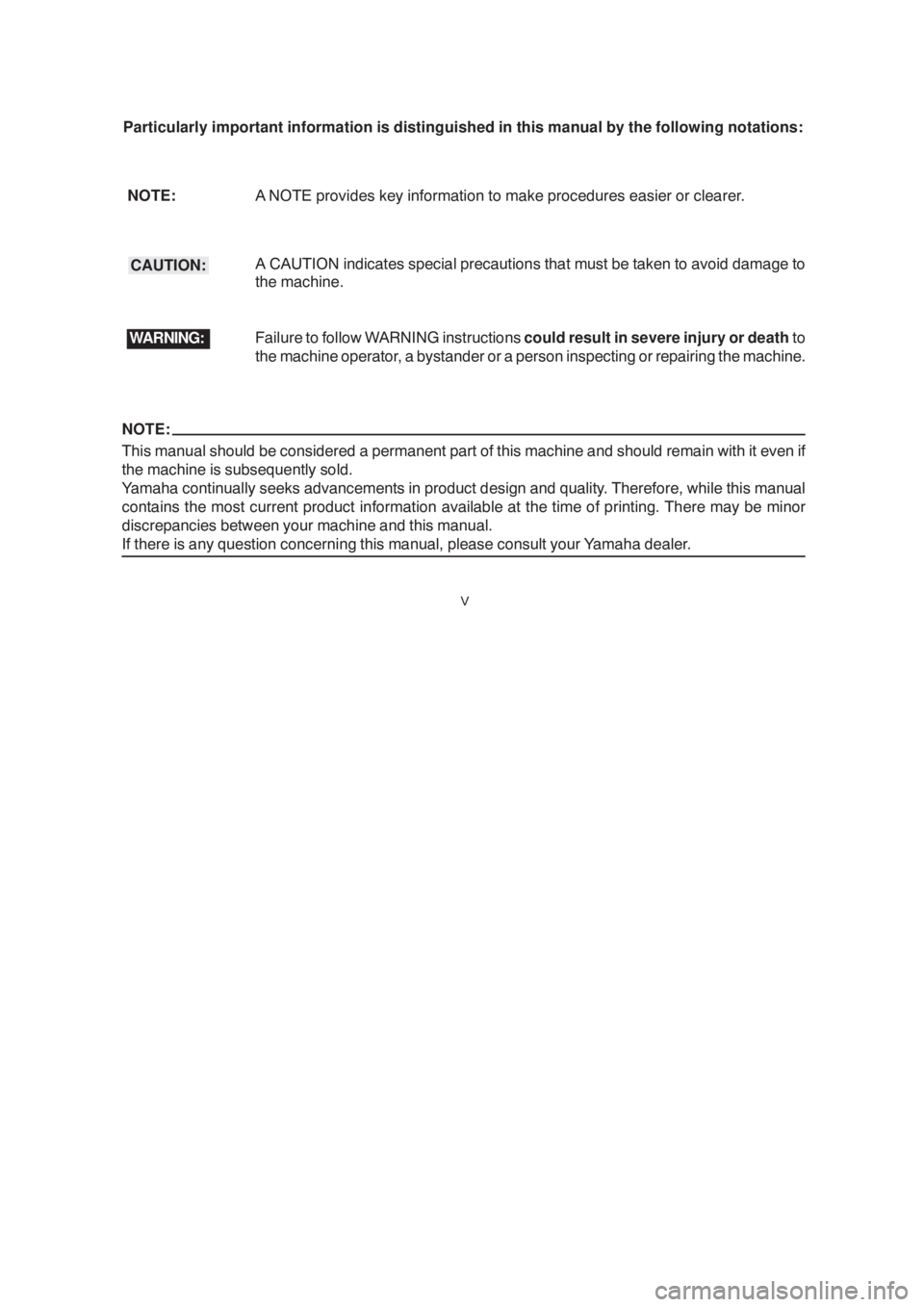
V
Particularly important information is distinguished in this manual by the following notations:
NOTE:A NOTE provides key information to make procedures easier or clearer.
A CAUTION indicates special precautions that must be taken to avoid damage to
the machine.
Failure to follow WARNING instructions could result in severe injury or death to
the machine operator, a bystander or a person inspecting or repairing the machine.
CAUTION:
WARNING:
NOTE:
This manual should be considered a permanent part of this machine and should remain with it even if
the machine is subsequently sold.
Yamaha continually seeks advancements in product design and quality. Therefore, while this manual
contains the most current product information available at the time of printing. There may be minor
discrepancies between your machine and this manual.
If there is any question concerning this manual, please consult your Yamaha dealer.
V
Particularly important information is distinguished in this manual by the following notations:
NOTE:A NOTE provides key information to make procedures easier or clearer.
A CAUTION indicates special precautions that must be taken to avoid damage to
the machine.
Failure to follow WARNING instructions could result in severe injury or death to
the machine operator, a bystander or a person inspecting or repairing the machine.
CAUTION:
WARNING:
NOTE:
This manual should be considered a permanent part of this machine and should remain with it even if
the machine is subsequently sold.
Yamaha continually seeks advancements in product design and quality. Therefore, while this manual
contains the most current product information available at the time of printing. There may be minor
discrepancies between your machine and this manual.
If there is any question concerning this manual, please consult your Yamaha dealer.
Page 10 of 83
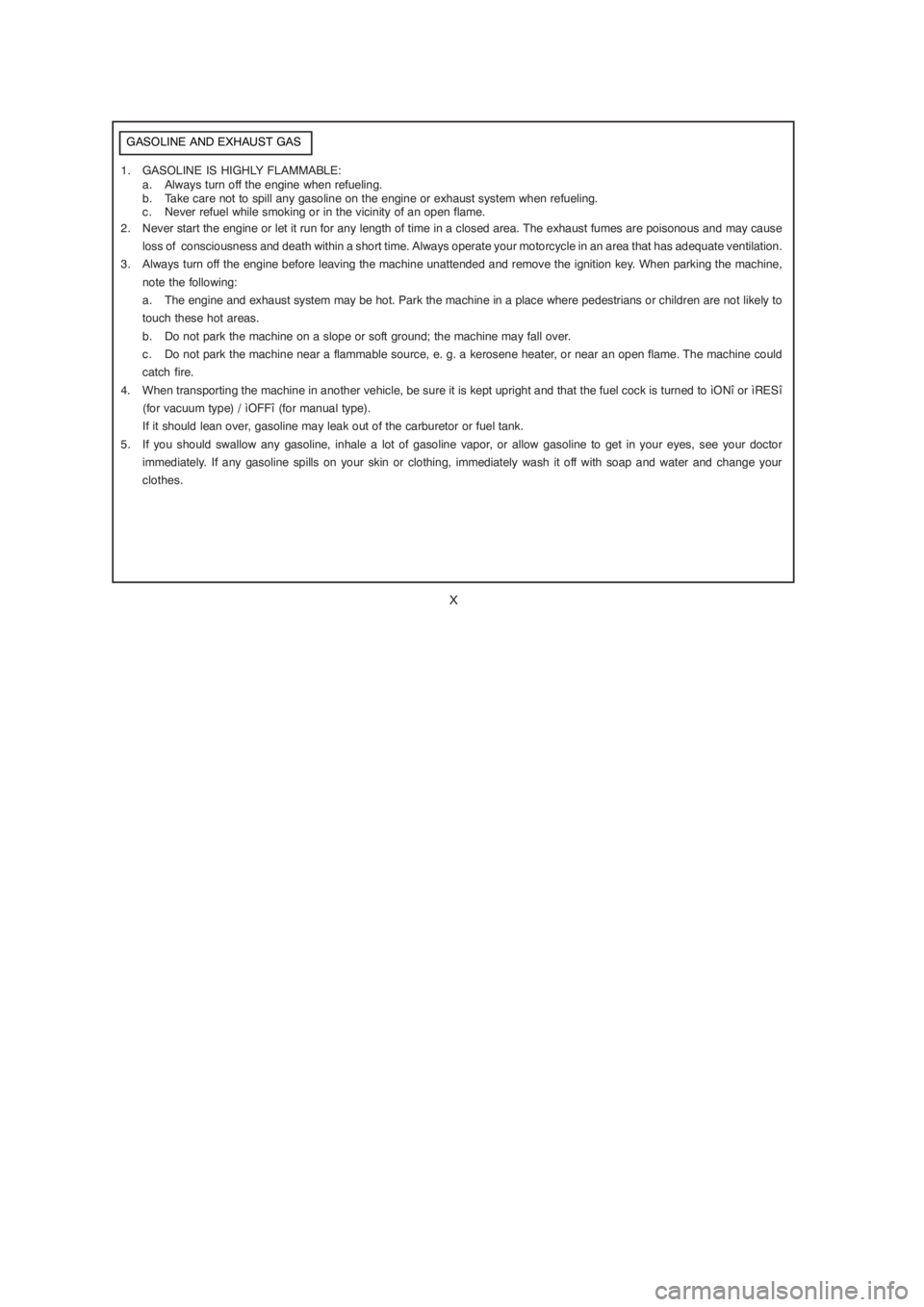
X
GASOLINE AND EXHAUST GAS
1. GASOLINE IS HIGHLY FLAMMABLE:
a. Always turn off the engine when refueling.
b. Take care not to spill any gasoline on the engine or exhaust system when refueling.
c. Never refuel while smoking or in the vicinity of an open flame.
2. Never start the engine or let it run for any length of time in a closed area. The exhaust fumes are poisonous and may cause
loss of consciousness and death within a short time. Always operate your motorcycle in an area that has adequate ventilation.
3. Always turn off the engine before leaving the machine unattended and remove the ignition key. When parking the machine,
note the following:
a. The engine and exhaust system may be hot. Park the machine in a place where pedestrians or children are not likely to
touch these hot areas.
b. Do not park the machine on a slope or soft ground; the machine may fall over.
c. Do not park the machine near a flammable source, e. g. a kerosene heater, or near an open flame. The machine could
catch fire.
4. When transporting the machine in another vehicle, be sure it is kept upright and that the fuel cock is turned to ìONî or ìRESî
(for vacuum type) / ìOFFî (for manual type).
If it should lean over, gasoline may leak out of the carburetor or fuel tank.
5. If you should swallow any gasoline, inhale a lot of gasoline vapor, or allow gasoline to get in your eyes, see your doctor
immediately. If any gasoline spills on your skin or clothing, immediately wash it off with soap and water and change your
clothes.
X
GASOLINE AND EXHAUST GAS
1. GASOLINE IS HIGHLY FLAMMABLE:
a. Always turn off the engine when refueling.
b. Take care not to spill any gasoline on the engine or exhaust system when refueling.
c. Never refuel while smoking or in the vicinity of an open flame.
2. Never start the engine or let it run for any length of time in a closed area. The exhaust fumes are poisonous and may cause
loss of consciousness and death within a short time. Always operate your motorcycle in an area that has adequate ventilation.
3. Always turn off the engine before leaving the machine unattended and remove the ignition key. When parking the machine,
note the following:
a. The engine and exhaust system may be hot. Park the machine in a place where pedestrians or children are not likely to
touch these hot areas.
b. Do not park the machine on a slope or soft ground; the machine may fall over.
c. Do not park the machine near a flammable source, e. g. a kerosene heater, or near an open flame. The machine could
catch fire.
4. When transporting the machine in another vehicle, be sure it is kept upright and that the fuel cock is turned to ìONî or ìRESî
(for vacuum type) / ìOFFî (for manual type).
If it should lean over, gasoline may leak out of the carburetor or fuel tank.
5. If you should swallow any gasoline, inhale a lot of gasoline vapor, or allow gasoline to get in your eyes, see your doctor
immediately. If any gasoline spills on your skin or clothing, immediately wash it off with soap and water and change your
clothes.
Page 15 of 83
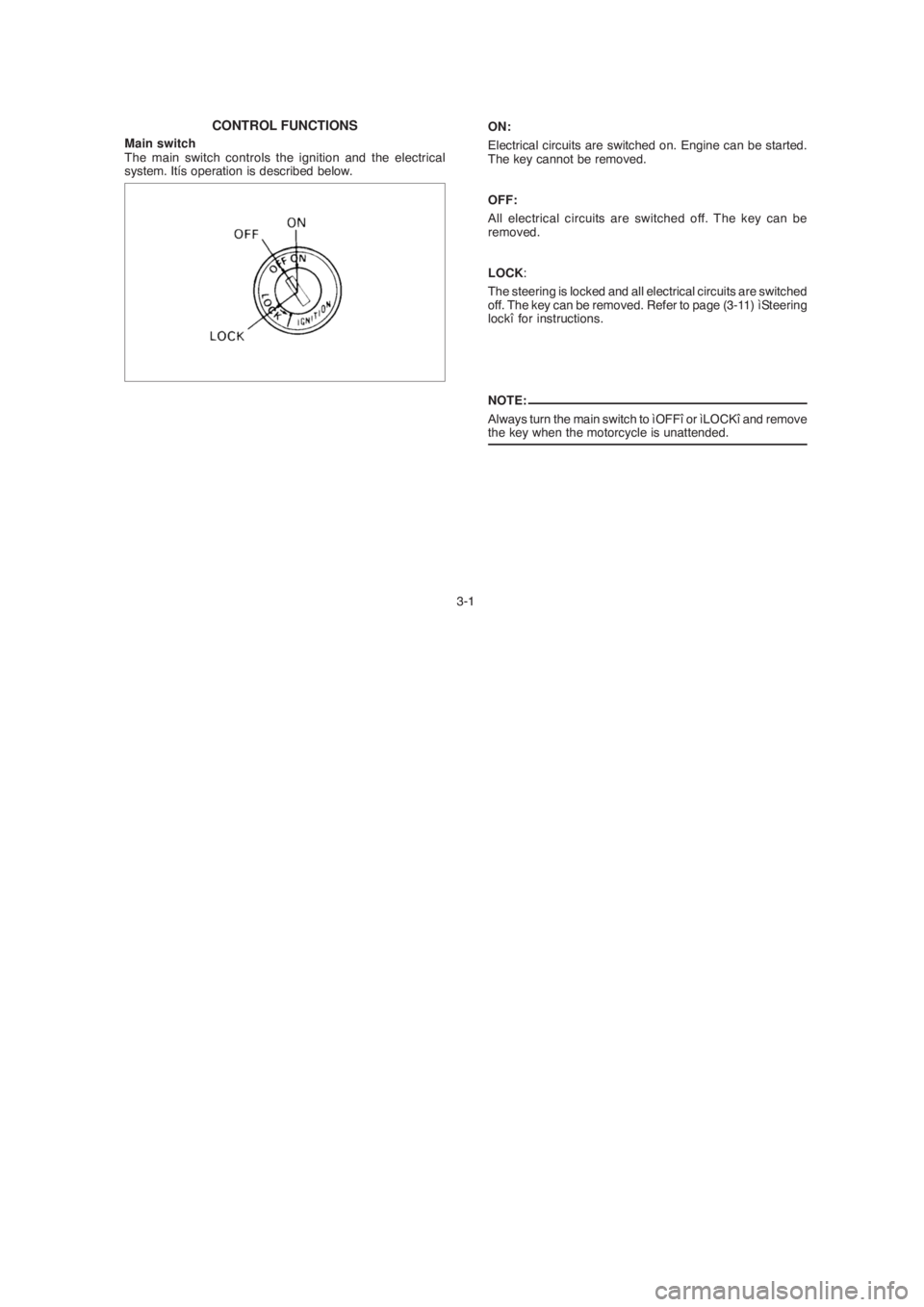
3-1
CONTROL FUNCTIONS
Main switch
The main switch controls the ignition and the electrical
system. Itís operation is described below.
ON:
Electrical circuits are switched on. Engine can be started.
The key cannot be removed.
OFF:
All electrical circuits are switched off. The key can be
removed.
LOCK:
The steering is locked and all electrical circuits are switched
off. The key can be removed. Refer to page (3-11) ìSteering
lockî for instructions.
NOTE:
Always turn the main switch to ìOFFî or ìLOCKî and remove
the key when the motorcycle is unattended.
3-1
CONTROL FUNCTIONS
Main switch
The main switch controls the ignition and the electrical
system. Itís operation is described below.
ON:
Electrical circuits are switched on. Engine can be started.
The key cannot be removed.
OFF:
All electrical circuits are switched off. The key can be
removed.
LOCK:
The steering is locked and all electrical circuits are switched
off. The key can be removed. Refer to page (3-11) ìSteering
lockî for instructions.
NOTE:
Always turn the main switch to ìOFFî or ìLOCKî and remove
the key when the motorcycle is unattended.
Page 22 of 83
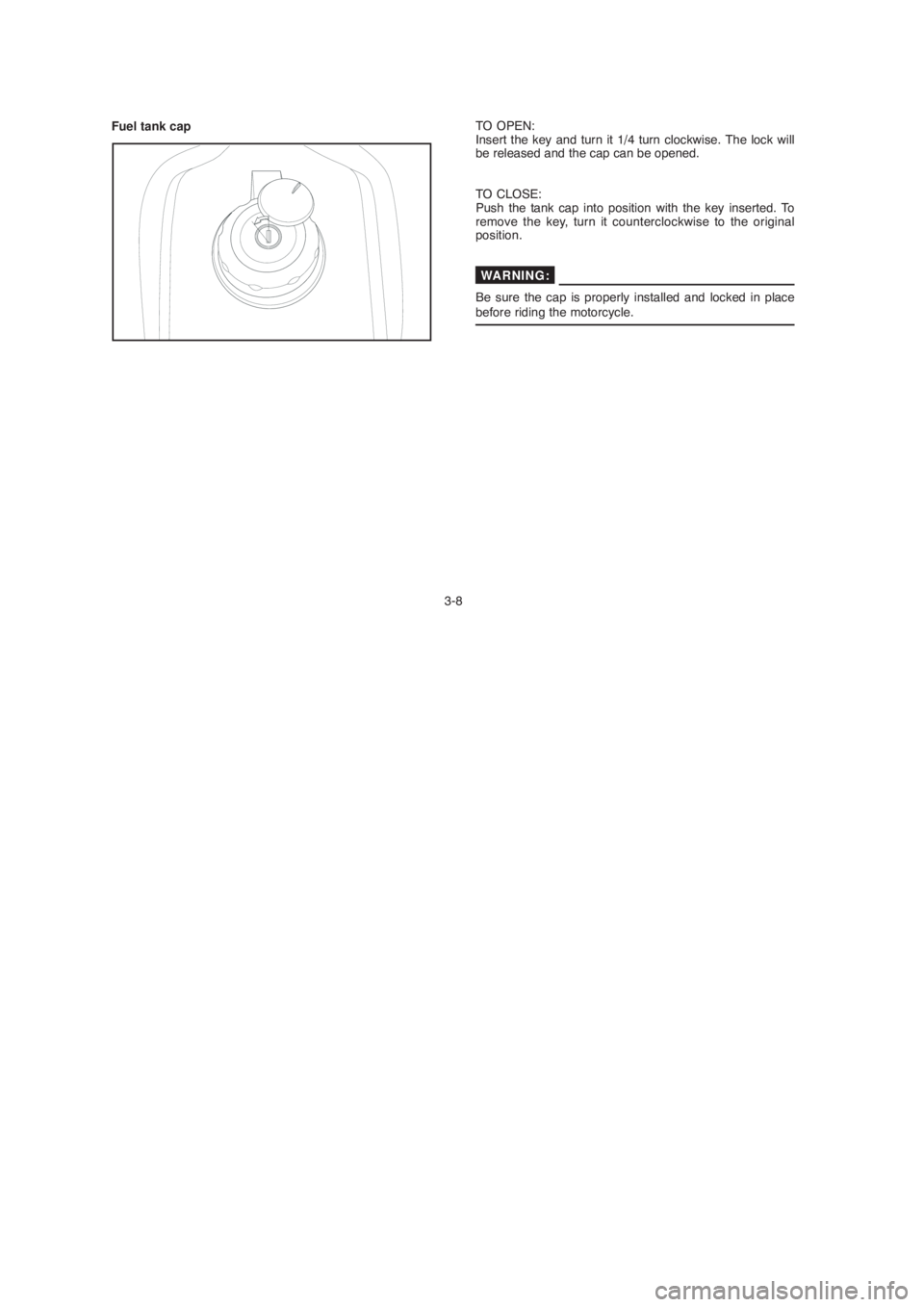
Fuel tank cap
3-8TO OPEN:
Insert the key and turn it 1/4 turn clockwise. The lock will
be released and the cap can be opened.
TO CLOSE:
Push the tank cap into position with the key inserted. To
remove the key, turn it counterclockwise to the original
position.
Be sure the cap is properly installed and locked in place
before riding the motorcycle.
WARNING:
Fuel tank cap
3-8TO OPEN:
Insert the key and turn it 1/4 turn clockwise. The lock will
be released and the cap can be opened.
TO CLOSE:
Push the tank cap into position with the key inserted. To
remove the key, turn it counterclockwise to the original
position.
Be sure the cap is properly installed and locked in place
before riding the motorcycle.
WARNING:
Page 25 of 83
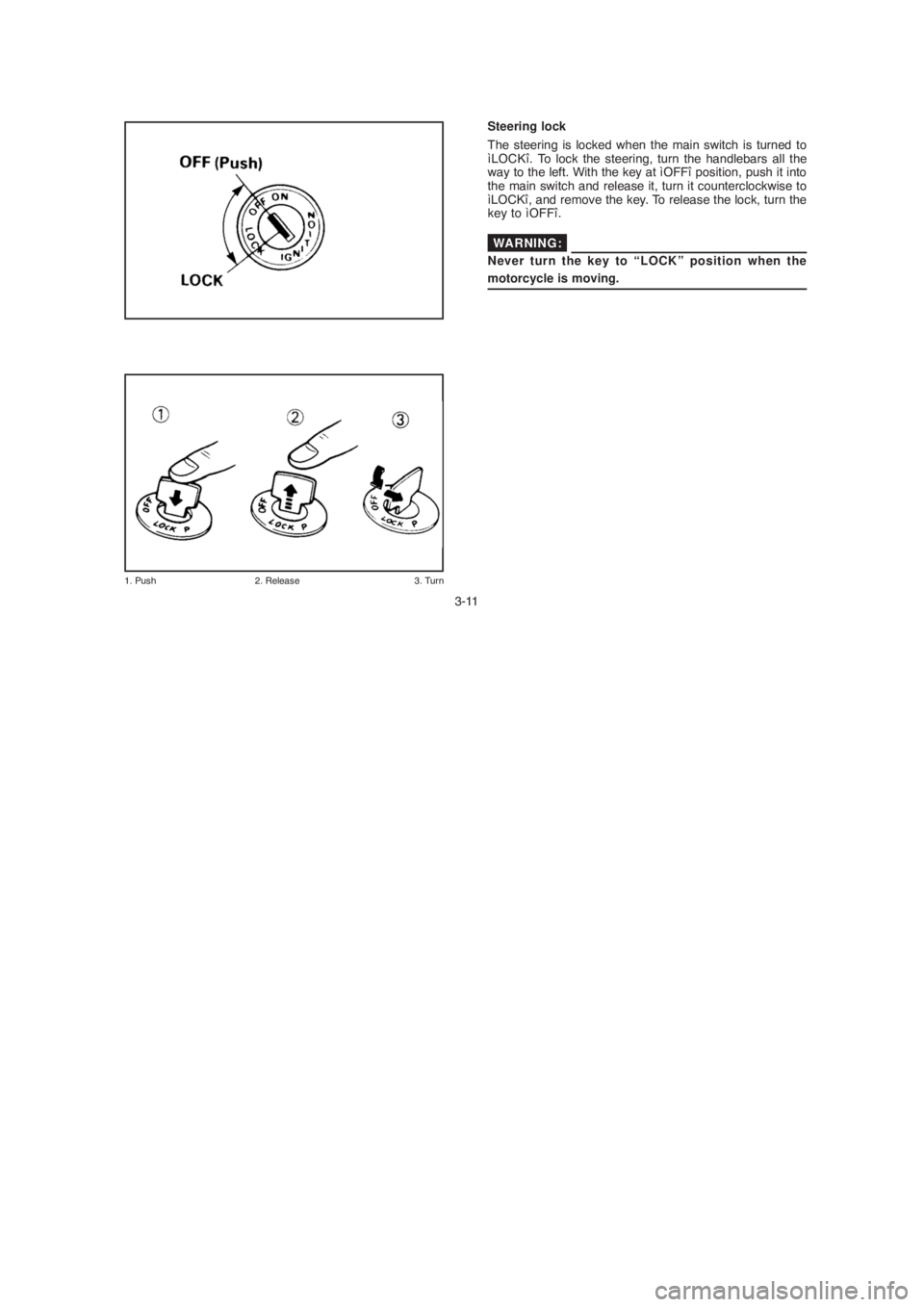
3-11
1. Push 2. Release 3. Turn
LOCK OFF (PUSH)
Steering lock
The steering is locked when the main switch is turned to
ìLOCKî. To lock the steering, turn the handlebars all the
way to the left. With the key at ìOFFî position, push it into
the main switch and release it, turn it counterclockwise to
ìLOCKî, and remove the key. To release the lock, turn the
key to ìOFFî.
Never turn the key to “LOCK” position when the
motorcycle is moving.
WARNING:
3-11
1. Push 2. Release 3. Turn
LOCK OFF (PUSH)
Steering lock
The steering is locked when the main switch is turned to
ìLOCKî. To lock the steering, turn the handlebars all the
way to the left. With the key at ìOFFî position, push it into
the main switch and release it, turn it counterclockwise to
ìLOCKî, and remove the key. To release the lock, turn the
key to ìOFFî.
Never turn the key to “LOCK” position when the
motorcycle is moving.
WARNING:
Page 27 of 83
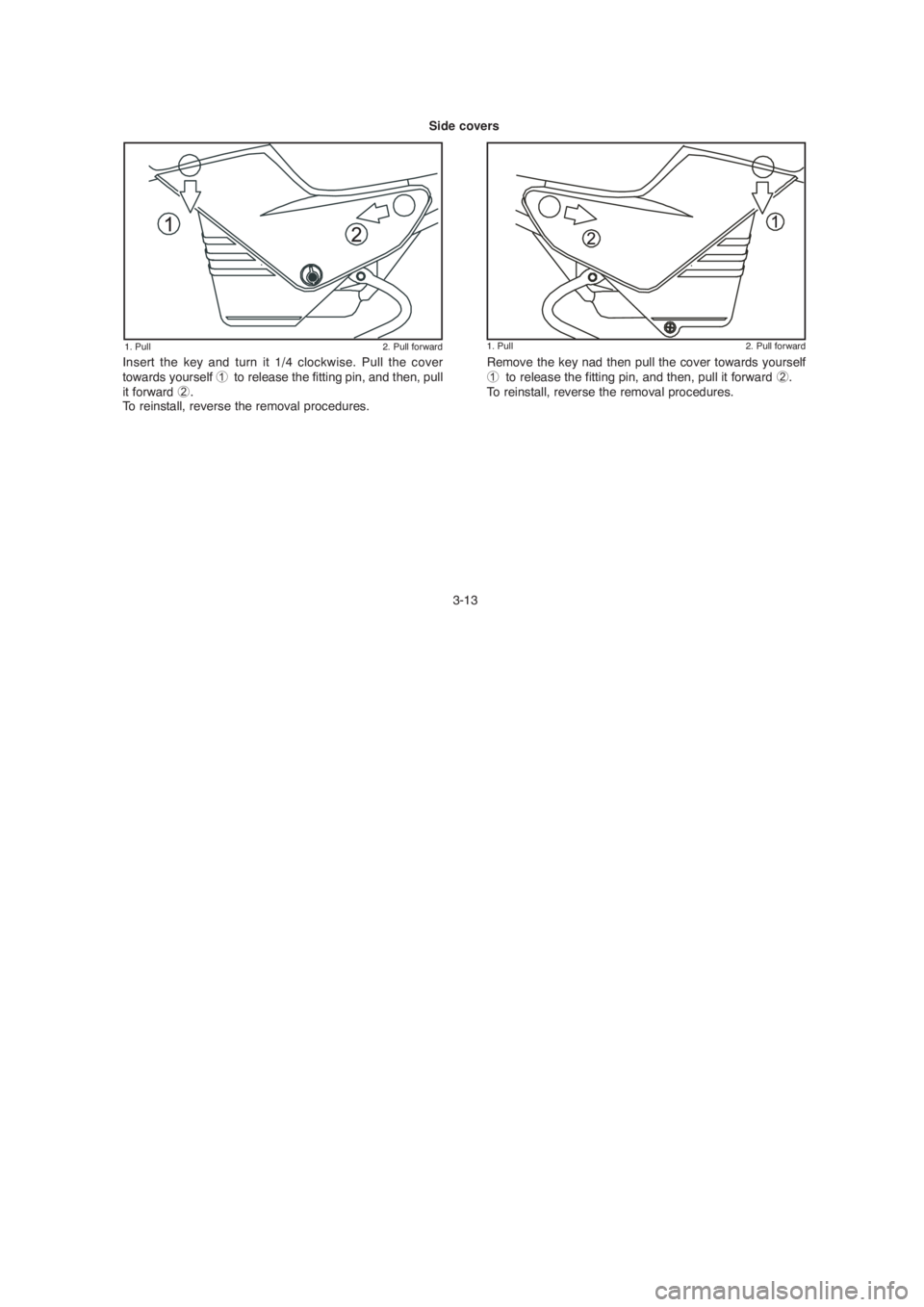
Insert the key and turn it 1/4 clockwise. Pull the cover
towards yourself 1 to release the fitting pin, and then, pull
it forward 2.
To reinstall, reverse the removal procedures.
3-13Remove the key nad then pull the cover towards yourself
1 to release the fitting pin, and then, pull it forward 2.
To reinstall, reverse the removal procedures.
Side covers
1. Pull 2. Pull forward1. Pull 2. Pull forward
Insert the key and turn it 1/4 clockwise. Pull the cover
towards yourself 1 to release the fitting pin, and then, pull
it forward 2.
To reinstall, reverse the removal procedures.
3-13Remove the key nad then pull the cover towards yourself
1 to release the fitting pin, and then, pull it forward 2.
To reinstall, reverse the removal procedures.
Side covers
1. Pull 2. Pull forward1. Pull 2. Pull forward
Page 40 of 83
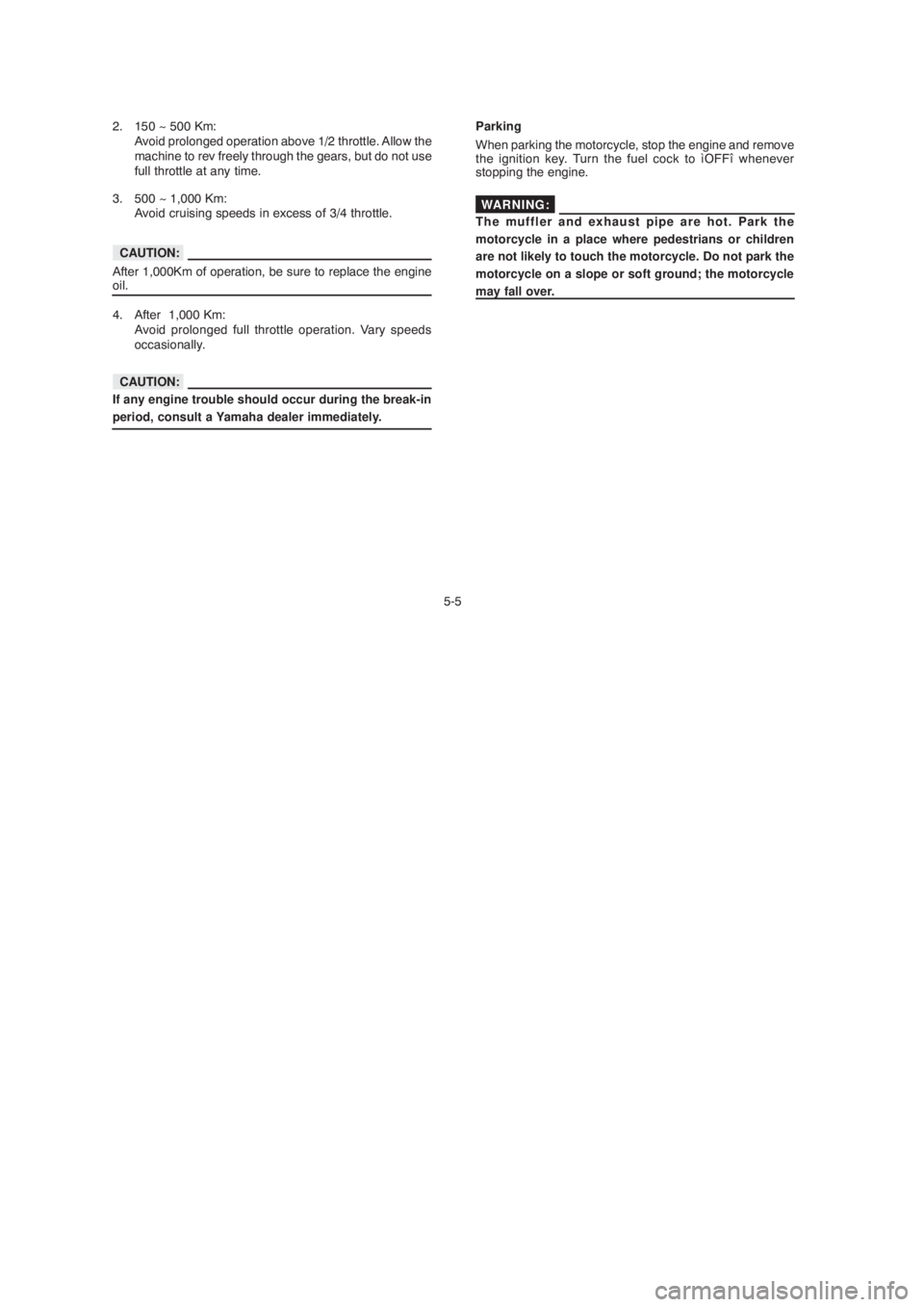
5-5 2. 150 ~ 500 Km:
Avoid prolonged operation above 1/2 throttle. Allow the
machine to rev freely through the gears, but do not use
full throttle at any time.
3. 500 ~ 1,000 Km:
Avoid cruising speeds in excess of 3/4 throttle.
After 1,000Km of operation, be sure to replace the engine
oil.
4. After 1,000 Km:
Avoid prolonged full throttle operation. Vary speeds
occasionally.
If any engine trouble should occur during the break-in
period, consult a Yamaha dealer immediately.Parking
When parking the motorcycle, stop the engine and remove
the ignition key. Turn the fuel cock to ìOFFî whenever
stopping the engine.
The muffler and exhaust pipe are hot. Park the
motorcycle in a place where pedestrians or children
are not likely to touch the motorcycle. Do not park the
motorcycle on a slope or soft ground; the motorcycle
may fall over.
CAUTION:
CAUTION:
WARNING:
5-5 2. 150 ~ 500 Km:
Avoid prolonged operation above 1/2 throttle. Allow the
machine to rev freely through the gears, but do not use
full throttle at any time.
3. 500 ~ 1,000 Km:
Avoid cruising speeds in excess of 3/4 throttle.
After 1,000Km of operation, be sure to replace the engine
oil.
4. After 1,000 Km:
Avoid prolonged full throttle operation. Vary speeds
occasionally.
If any engine trouble should occur during the break-in
period, consult a Yamaha dealer immediately.Parking
When parking the motorcycle, stop the engine and remove
the ignition key. Turn the fuel cock to ìOFFî whenever
stopping the engine.
The muffler and exhaust pipe are hot. Park the
motorcycle in a place where pedestrians or children
are not likely to touch the motorcycle. Do not park the
motorcycle on a slope or soft ground; the motorcycle
may fall over.
CAUTION:
CAUTION:
WARNING: